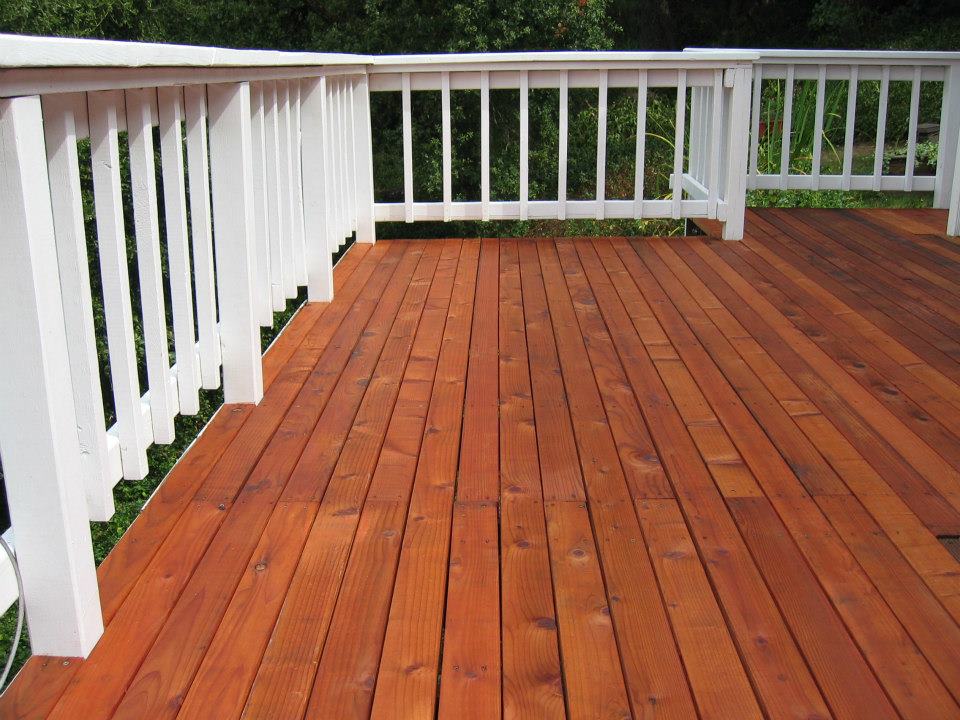Maintenance
Our maintenance programs are tailored to your specific wooden deck. Wood sealers and deck stains are meant as the first line of defense against the elements. Replenishing these coatings before they breakdown greatly reduces the frequency of full deck refinishing and ensures continuous beauty and protection in the most economical way. Our deck refinishing and maintenance services are available from Corralitos to Scotts Valley. We also have many satisfied clients in Aptos, Soquel, Capitola, Santa Cruz, and Santa Cruz Mountain areas.
We’ve restored and protected over one million square feet of decking! Deck maintenance is essential to protect your investment and the overall beauty of your property. Proper cleaning and sealing every two to three years is critical to maintain the safety and beauty of your deck. Don’t take chances with inexperienced contractors that could leave your deck damaged or not fully protected. Our customers say that they find it much easier to stay on schedule with their deck maintenance by having Deck Medic just a phone call away.
Deck Care Dos and Don’ts
DO clean the deck thoroughly once a year.
Your deck needs an annual exfoliation so protective sealers can seep deeper into the wood. When it’s dry and moderately warm—60 to 70 degrees Fahrenheit—apply an appropriate deck-cleaning solution with a roller or sprayer to kill mold and bacteria. Use a utility brush to scrub the deck where it’s especially dirty and where mold or mildew might lurk. (Power washers and pressure washers are the quickest way to clear residue, but you risk gouging the wood. A garden hose outfitted with any nozzle that has a hard-stream setting will work; a “fireman” nozzle, found in auto-parts stores, delivers an intense spray without the risks associated with a pressure washer.)
DON’T go overboard with the high-powered washer.
The power or pressure washer is a time- and labor-saving tool, but in unsteady hands, it can make your deck look like wood-boring beetle larvae have been at work. Sweep the nozzle along the wood grain at a slight angle about 8 inches from the deck surface. Move the nozzle at all times while the trigger is engaged.
DO cover nearby shrubbery before you begin.
The chemicals in cleaners and sealers can harm or kill plants that are hit with overspray. Cover all nearby vegetation with a tarp or plastic sheet before you start, but drape it loosely to allow air circulation.
DON’T clean the deck with chlorine bleach.
Unless, of course, you don’t mind stripping the wood of its natural color and damaging its cellular structure. Oxygen bleach is an all-purpose alternative that won’t wash out colors or harm plants, but it’s still not appropriate for redwood.
DO sand your deck before sealing.
It can take up to 48 hours for the deck to fully dry. At that point, lightly sand the surface to remove splintery or fuzzy patches caused by pressure-washing the deck. A pole sander with 80-grit sandpaper will suffice; a power sander is overkill. Then seal the deck to protect from cracking, cupping, and warping. A clear sealer lasts longer; a tinted stain or sealant fades quickly with lots of foot traffic.
DON’T use paint as a sealant.
Paint looks nice when it’s first applied, but it looks downright distressed before long. If you then decide to refinish the deck with an alternative sealant, you’ll need to first remove all the paint with a stripper or sander. Finishes that leave a film rather than penetrating the wood—including varnishes and lacquer—will peel and crack. Consider synthetic sealants, as some oil-based products attract mildew and algae. Semi-transparent finishes protect the deck from sun damage and add color to the wood if that’s important to you.
Deck Maintenance – Power Washing Wooden Deck
DO clean the deck at routine intervals.
The room and walls of your home protect its interior from rain, snow, sun, and wind, but the uncovered deck endures whatever Nature delivers. Prevent water damage throughout the season—and during the off-season—by regularly sweeping away puddled water, leaves, branches, and other debris. Use a plastic shovel if you get more snow than a push broom can handle.
DON’T assume that pressure-treated wood is maintenance-free.
It might resist rot and insect infestation, but pressure-treated wood still needs to be cleaned and sealed to withstand water and solar damage. Use products made for pressure-treated wood.
DO be vigilant about damage.
Inspect periodically for soft or splintered spots, loose nails and deck attachments, and split or rotten planks. Promptly fix any damage that presents a health or safety hazard. Complete other repairs before your annual deep-clean.
DON’T use natural materials under deck furniture.
Protect the wood deck from scrapes inflicted by chair and table legs, but don’t use rugs made of natural fibers such as jute and bamboo: These absorb moisture and promote mildew. Rugs made of recycled plastics won’t cause these problems, and they’ll last longer.

